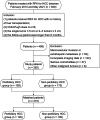Radiofrequency ablation for peribiliary hepatocellular carcinoma: propensity score matching analysis
- PMID: 39971810
- PMCID: PMC11839967
- DOI: 10.1186/s13244-025-01919-5
Radiofrequency ablation for peribiliary hepatocellular carcinoma: propensity score matching analysis
Abstract
Objectives: At present, there are no established clinical guidelines for radiofrequency ablation (RFA) of peribiliary hepatocellular carcinoma (HCC). Therefore, the aim of this study was to compare the long-term outcomes of RFA for peribiliary vs. non-peribiliary HCC.
Methods: This retrospective study included 282 patients with peribiliary HCC (n = 109) or non-peribiliary HCC (n = 173) who received RFA between February 2013 and May 2021. Local tumor progression (LTP), overall survival (OS), disease-free survival (DFS), and complications were compared before and after propensity score matching (PSM).
Results: Before PSM, there were no significant differences in 5-year LTP rates (26.3% vs. 23.6%, p = 0.602), OS rates (56.6% vs. 68.0%, p = 0.586), or DFS rates (22.9% vs. 25.7%, p = 0.239) between the peribiliary and non-peribiliary groups. After PSM, there were no significant differences in the 1-, 3-, and 5-year LTP rates (13.0%, 23.1%, and 26.3% vs. 12.1%, 25.1%, and 28.2%, respectively, p = 0.857), OS rates (97.2%, 73.5%, and 56.6% vs. 95.3%, 79.5%, and 70.6%, p = 0.727), or DFS rates (59.4%, 29.4%, and 22.9% vs. 64.2%, 33.1%, and 23.8%, p = 0.568) between the peribiliary non-peribiliary groups. Peribiliary location was not a significant prognostic factor for LTP (p = 0.622) or OS (p = 0.587). In addition, mild intrahepatic bile duct dilatation was more frequent in the peribiliary group (9.2% vs. 2.8%, p = 0.045).
Conclusion: Long-term outcomes of RFA were similar for peribiliary and non-peribiliary HCC. RFA is a viable alternative for treatment of peribiliary HCC.
Critical relevance statement: The local tumor progression (LTP), overall survival (OS), and disease-free survival (DFS) rates after radiofrequency ablation (RFA) were similar for peribiliary and non-peribiliary hepatocellular carcinoma (HCC).
Key points: There are currently no clinical guidelines for radiofrequency ablation (RFA) of peribiliary hepatocellular carcinoma (HCC). Local tumor progression, overall survival, and disease-free survival after RFA were similar for peribiliary and non-peribiliary HCC. RFA is a viable alternative for the treatment of peribiliary HCC.
Keywords: Hepatocellular carcinoma; Peribiliary location; Radiofrequency ablation; Therapeutic outcome.
© 2025. The Author(s).
Conflict of interest statement
Declarations. Ethics approval and consent to participate: This study was approved by the Institutional Review Board of Shandong Provincial Hospital. The requirements for informed consent were waived due to the retrospective nature. Consent for publication: All the authors agreed to the publication of this manuscript. Competing interests: The authors declare that they have no conflict of interest.
Figures






Similar articles
-
LI-RADS category is associated with treatment outcomes of small single HCC: surgical resection vs. radiofrequency ablation.Eur Radiol. 2024 Jan;34(1):525-537. doi: 10.1007/s00330-023-09998-y. Epub 2023 Aug 1. Eur Radiol. 2024. PMID: 37526668
-
Small single perivascular hepatocellular carcinoma: comparisons of radiofrequency ablation and microwave ablation by using propensity score analysis.Eur Radiol. 2021 Jul;31(7):4764-4773. doi: 10.1007/s00330-020-07571-5. Epub 2021 Jan 5. Eur Radiol. 2021. PMID: 33399908 Free PMC article.
-
Microwave ablation for peribiliary hepatocellular carcinoma: propensity score analyses of long-term outcomes.Int J Hyperthermia. 2021;38(1):191-201. doi: 10.1080/02656736.2019.1706766. Int J Hyperthermia. 2021. PMID: 33682598
-
Comparison of liver resection and radiofrequency ablation in long-term survival among patients with early-stage hepatocellular carcinoma: a meta-analysis of randomized trials and high-quality propensity score-matched studies.World J Surg Oncol. 2024 Feb 19;22(1):56. doi: 10.1186/s12957-024-03330-8. World J Surg Oncol. 2024. PMID: 38369480 Free PMC article.
-
Laparoscopic liver resection is superior to radiofrequency ablation for small hepatocellular carcinoma: a systematic review and meta-analysis of propensity score-matched studies.Hepatol Int. 2024 Jun;18(3):998-1010. doi: 10.1007/s12072-024-10645-x. Epub 2024 Mar 14. Hepatol Int. 2024. PMID: 38480604
Cited by
-
Photodynamic therapeutic activity of novel porphyrins against lung squamous cell carcinoma.BMC Cancer. 2025 May 28;25(1):960. doi: 10.1186/s12885-025-14386-4. BMC Cancer. 2025. PMID: 40437394 Free PMC article.
References
-
- European Association for the Study of the Liver (2018) EASL clinical practice guidelines: management of hepatocellular carcinoma. J Hepatol 69:182–236 - PubMed
-
- Heimbach JK, Kulik LM, Finn RS et al (2018) AASLD guidelines for the treatment of hepatocellular carcinoma. Hepatology 67:358–380 - PubMed
-
- Ohnishi T, Yasuda I, Nishigaki Y et al (2008) Intraductal chilled saline perfusion to prevent bile duct injury during percutaneous radiofrequency ablation for hepatocellular carcinoma. J Gastroenterol Hepatol 23:e410–e415 - PubMed
-
- Lin MX, Ye JY, Tian WS et al (2017) Risk factors for bile duct injury after percutaneous thermal ablation of malignant liver tumors: a retrospective case-control study. Dig Dis Sci 62:1086–1094 - PubMed
-
- Kai J, Ming S, Yang L et al (2013) Complete radio frequency ablation of hepatocellular carcinoma adjacent to the main bile duct and blood vessels between the first and the second hepatic portal. Cell Biochem Biophys 66:397–402 - PubMed
Grants and funding
LinkOut - more resources
Full Text Sources
Miscellaneous

